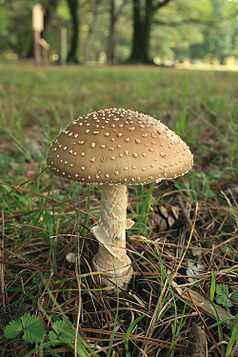Amanullin
 | |
 | |
| Names | |
|---|---|
| Other names
3-Isoleucine-alpha-amanitin | |
| Identifiers | |
| 21803-57-6 | |
| ChemSpider | 102814 |
| |
| Jmol-3D images | Image Image |
| PubChem | 114856 |
| |
| Properties | |
| C39H54N10O12S | |
| Molar mass | 886.86 g/mol |
| Appearance | Colorless, crystalline solid |
| Soluble | |
| Solubility in ethanol, methanol | Soluble |
| Except where noted otherwise, data is given for materials in their standard state (at 25 °C (77 °F), 100 kPa) | |
| | |
| Infobox references | |
Amanullin is a cyclic nonribosomal peptide. It is an amatoxin, all of which are found in several members of the Amanita genus of mushrooms. The oral LD50 of amanullin is approximately 20 mg/kg in mice, however it is non-toxic in humans.
Toxicology
Like other amatoxins, amanullin is an inhibitor of RNA polymerase II. Amanullin has a species dependent and specific attraction to the enzyme RNA polymerase II. Upon ingestion, it binds to the RNA polymerase II enzyme, effectively causing cytolysis of hepatocytes (liver cells).[1]
See also
References
- ↑ Cochet-Meilhac M, Chambon P (June 1974). "Animal DNA-dependent RNA polymerases. 11. Mechanism of the inhibition of RNA polymerases B by amatoxins". Biochim. Biophys. Acta 353 (2): 160–84. doi:10.1016/0005-2787(74)90182-8. PMID 4601749.
External links
- Amatoxins REVISED
- Poisonous Mushrooms (German)
| ||||||||||||||||||||||||||||||||||||||||||||||||||||||||||||
